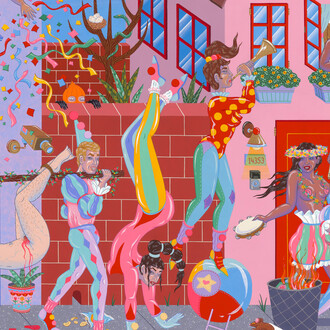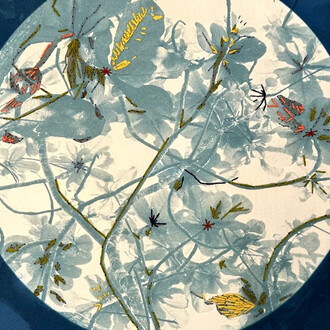The words My paradise bring to mind fantasies of elsewhere.
Here they describe the opposite—an expansive state of present possibility, outside the finality of destination, where, like a feeling embodied, the continuous motion of play has become a place.
Through a process of action-oriented research, Molly Rose Lieberman produces paintings, sculptures, and works on paper reconfiguring the ephemeral tissue binding thought and reality into joyful models of perception which, through a delicate mixture of layering strategies, reveal self-illuminated contours made visible in the flickering rhythm of their material reciprocity.
My paradise is anchored around two steel columns. One is found. The latter is a replica of the former. Through a series of modifications, each has been transformed into a bench. Like welcomed ideas, these reimagined objects lay unburdened in their newly assigned horizontal orientation. And while the memory of their upright posture carries a forceful dramatization of individuated space, turned on their side, the columns now deploy an invitation to indulge in the commonality of gravity their vertical stance once worked to delay. They run parallel to the earth’s surface, rather than in opposition to it, celebrating a discrete harmony with the world from which they’ve been pulled.
Radically simple gestures like turning vertical columns horizontal are foundational to Lieberman’s work. Whereas most singular objects can’t help but embody the inherent limitations of their physical existence, Lieberman’s creations contain the capacity of a prism. They absorb gaze only to break it, twirling the fragments of one’s expectations into a seductive dance-like progression of infinitesimal chain reactions through which latent pluralities eventually ring out.
Take for example Respect the morning, a painting that contains as its underlying structure the phrase for which it’s titled. Like the painting, the expression remains tonally open-ended in its address while positioning the voyeur—whether the artist herself or any individual considering the work—in relation to the universally known condition of beginning a day. As a consequence, the cyclical nature of existence is called into question. Morning is also an end, as the process of dawn ultimately begins at dusk, and vice versa.
A sculpture titled Ashtray furthers this line of inquiry. Contained as part of its structure is a small silver box filled with a set of initial abstractions Lieberman created as inspiration for the work in the exhibition. Like most beginnings, the small silver box and its contents are not immediately visible in the reorganized body of their present form, however, their inclusion is a reminder of a fundamental truth: all things are containers of their source.
Like the contents of the small silver box, My paradise is also a summary; a non-prescriptive language modeled in the future potentialities it describes.
(Text by Joel Dean)
Molly Rose Lieberman (b. 1994, Brooklyn) lives and works in New York. She received her Master’s in Library Science from Queens College in 2024 and Bachelor of Arts from Oberlin College in 2016.
Previous solo exhibitions include Alive girl, Theta, New York (2023); The wind wakes me up, Gern en Regalia, New York (2021); Sunken swimmer, Gymnasium, Brooklyn (2020).
Selected group exhibitions include Group show (forthcoming), Greene Naftali, New York; Pinacotheca, Theta, NY (2024); Paper trail, Matthew Brown, Los Angeles (2023); Elective affinities, Chapter, New York (2022); Sense of place, Greene Naftali, New York (2022); You’re finally awake!, Theta, New York (2022); Remnant, Artifact, Flow, Thierry Goldberg, New York (2020).
Special thanks to Jordan Barse, Joel Dean, Joseph Schlam, and Maggie Zheng.













